The terms “odor control” and “air emissions” cover various types of off-gas contaminants regulated by law, standard, or just by need. Air emissions and the odors created can be identified as some type of off-gas condition, whether it is noxious, corrosive, or dangerous for human or animal exposure. Because of these associated risks with odorous air emissions, many types of air emissions and different processes that create odorous air emissions are carefully regulated within many countries. The United States maintains the most stringent regulations of all countries, and all industries must comply with air emission requirements.
We will examine and explore the different types of odor control problems associated with off-gas air emissions and the various treatments utilized in today’s market and industry that successfully treat and process the off-gas odor emissions to remain compliant and provide safe working environments. Odors from air emissions and hazardous off-gases can be produced from several sources, including:
- Agriculture
- Asphalt Production
- Chemical Production
- Food Processing
- Industrial
- Municipal
- Painting Industry
- Petroleum Refining
- Semi-Conductor Industry
- And other
Shortcuts
ODOR CONTROL SCRUBBERS COME IN DIFFERENT SIZES
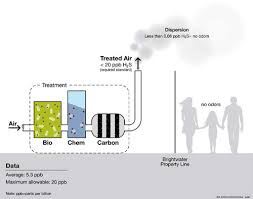
The industry has developed different processes to capture, treat, and neutralize the various odors and off-gas air emissions. The process systems are commonly referred to as “odor control scrubbers.” Odor control scrubbers come in different types and sizes and allow our industry to operate and maintain safe working conditions and achieve regulatory compliance. Odor control scrubbers are typically vertically packed towers normally. However, some can be shorter and more shaped like a box than a tower, which is used for indoor applications or where height is restricted. A vertical tower can be manufactured from steel, stainless steel, fiberglass, and PVC. When utilizing steel, the internals are typically covered by a rubber or epoxy coating, and the other material typically requires no internal form of corrosion protection. With all types and shapes or sizes of scrubbers, there are certain commonalities among all manufacturers. That is the need to interact the contaminated air flow with some treatment process.
When examining a vertical-type packed odor control scrubber
you will see where the contaminated air enters the tower at the bottom section, typically injected by a mechanical blower or from receiving the contaminated gas stream generated and duct to the tower location. The contaminated gas enters the base and travels upwards to the top of the tower. As the gas travels upward, it passes through some type of media bed. The type of media bed can vary, as can their depth, and the diameter of the bed and the tower also vary dimensionally. These variables are controlled by the concentration of the contaminated air stream, the required hydraulic load of the airflow, and the recirculating agent utilized in the tower.
If the odor control scrubber tower is a “chemical type” odor control scrubber
then it will have a re-circulation pump and a chemical feed injection system as part of its components. The chemical re-circulation system circulates a chemical solution to the top of the tower, where it is evenly injected across the media bed. The chemical solution then travels downward by gravity across the media bed to the bottom of the tower, where it collects in the tower sump. Then, the re-circulation pump system extracts the chemical solution and recirculates it back up to the tower again. This process is continuous, and the chemical re-circulation system is a loop. As the chemical solution travels downward thru the media bed, it comes into contact with the contaminated airflow as it travels upward. The air contaminant traveling upward in the Odor Control Scrubber will be removed by either a “reaction’ or an “absorption” process to the specified design conditions or a maximum achievable removal level. Some air contaminants react to chemicals and oxides or convert to other less harmful solutions. In contrast, other contaminants are removed by absorbing the pollutant back into the chemical or water solution.
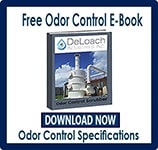
A similar process is utilized when using a “horizontal” or “cross flow” type chemical odor control scrubber.
The difference between a vertical scrubber and a horizontal cross-flow is that the air travels sideways from one side of the scrubber to the other side before exiting the scrubber. The contaminated air still comes into direct contact with the media inside the scrubber and the chemical agents used to treat and neutralize the contaminated air. The main difference between the two types is height. The horizontal scrubber is a perfect choice for locations with limited height so long as the concentrations are not too high. If the concentration levels are low, this can provide a viable solution for an air emission problem. With a vertical tower, if concentrations are higher, the tower height is increased to support larger media beds and increase reaction time.
ODOR CONTROL SCRUBBERS COME IN DIFFERENT TYPES
Industrial Chemical Odor Control Scrubbers
Industrial chemical odor control scrubbers are one type of odor control scrubber designed specifically to treat the levels of air contaminants. Still, like many processes, there are different types and options for treating an air emission or gas odor source. These other chemical odor control scrubbers include “single-stage” and two-stage chemical scrubbers, also called “dual pass” chemical odor control scrubbers. Both odor control scrubbers utilize chemical reagents or a liquid water re-circulation process to achieve results. A very common chemical scrubber is a “hydrogen sulfide (H2S) scrubber” or H2S scrubber and is utilized at industrial and municipal water treatment plants. Hydrogen sulfide gas is extracted during the water purification process, and the gas is released into the air from a process called “degasification.” Water treatment involving reverse osmosis or membrane filtration degasification typically follows post-filtration to remove dissolved gases to enhance the treatment process and raise the pH of the water without additional chemical usage. The off gases that are removed often contain high levels of hydrogen sulfide (H2S) and carbon dioxide (CO2) and, if left untreated, create a corrosive condition for the surrounding equipment, a noxious odor, and it can create a hazardous situation for workers if levels are above 1 PPM (parts per million).
The other application you commonly find chemical odor control scrubbers is in the wastewater treatment industry. When wastewater treatment plants (WWTP) process and break down waste, there are gases released during the process, and often, because of development growth and the location of the WWTP, the off-gases must be captured and treated. A standard contaminant of a WWTP is hydrogen sulfide (H2S), similar to a water plant but often at much higher concentrations. Food processing plants also commonly have hydrogen sulfide and other gas contaminants released during the food processing cycle.
The semiconductor industry also releases air emission contaminants during manufacturing, requiring odor control scrubbers to capture and treat the air contaminants to meet regulatory and safe working standards. These scrubbers can be utilized in a single pass or dual pass to neutralize fumes created during manufacturing. DeLoach Industries manufactures various industrial chemical scrubbers for the semiconductor and food processing industry. Some chemical scrubbers utilized in the semiconductor industry are referred to as fume scrubbers or acid fume scrubbers.
Biological odor control scrubbers
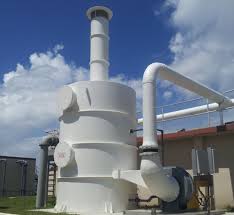 A biological scrubber utilizes active bacteria colonies cultured to a media bed within the scrubber and acclimated to the specific contaminant, which acts as a food source for the bacteria. The biological scrubber also has a re-circulation system used for moisture control and to deliver nutrients to the bacteria colony when needed. The scrubber contains a different type of media bed, typically an organic or porous substance. Biological odor control scrubbers operate well in organic and inorganic gas streams but perform their best when the concentration levels are consistent, and the gas air stream is not hostile to the bacteria colony. The pH in the re-circulation system must also be maintained to keep the bacteria colony healthy. If the concentration levels in the air gas stream spike, you will have a “breakthrough,” and untreated gas emissions will leave the scrubber. This occurs because the bacteria colony has been cultured and explicitly grown to the size of the food source available unless a nutrient feed system is utilized. Odor control selection depends on the type of air contaminant you are treating, the concentration of the contaminant, and whether it is an odorous gas needing odor control or a corrosive gas requiring neutralization.
A biological scrubber utilizes active bacteria colonies cultured to a media bed within the scrubber and acclimated to the specific contaminant, which acts as a food source for the bacteria. The biological scrubber also has a re-circulation system used for moisture control and to deliver nutrients to the bacteria colony when needed. The scrubber contains a different type of media bed, typically an organic or porous substance. Biological odor control scrubbers operate well in organic and inorganic gas streams but perform their best when the concentration levels are consistent, and the gas air stream is not hostile to the bacteria colony. The pH in the re-circulation system must also be maintained to keep the bacteria colony healthy. If the concentration levels in the air gas stream spike, you will have a “breakthrough,” and untreated gas emissions will leave the scrubber. This occurs because the bacteria colony has been cultured and explicitly grown to the size of the food source available unless a nutrient feed system is utilized. Odor control selection depends on the type of air contaminant you are treating, the concentration of the contaminant, and whether it is an odorous gas needing odor control or a corrosive gas requiring neutralization.
Selecting the proper odor control
can be challenging to understand performance versus capital cost versus operating cost versus ease of operation. Odor control selection is often left up to design professionals who have experience understanding the different variables that must be considered when choosing what type of odor control process to select. Most trained design professionals and manufacturers of odor control equipment like DeLoach Industries understand that the capital cost of the equipment is only one part of the equation, and often, it is the smallest part of the equation. Owners who operate in more than one location and have experience with odor control and air emission requirements will recognize the need to evaluate different types of odor control processes and understand the operating cost and conditions of each system assessed. Suppose the wrong kind of odor control scrubber is selected. In that case, it can not only underperform and leave untreated air emissions and odors, but it can also have a high operating cost and require high maintenance levels and media cleaning or replacement. A chemical odor control scrubber should “react” and “convert” the contaminants in the air stream or neutralize them to the levels required. Selecting a single or dual stage is often needed if the concentration levels are higher and the conditions require longer residence time within the odor control scrubber.
Make sure you understand the parameters for the odor control scrubber
because if you don’t, the consequences can be damaging. Understanding the dos and don’ts of odor control selection and operations can save thousands of dollars and protect your system components, such as equipment and electronics. Many things need to be examined when designing a solution for an air emission problem that will require an odor control system or fume scrubber. It is a good idea to fully understand where the odorous gas comes from and how it is produced to address the many variables required during the design and selection phase. It is also essential to understand how the system you select will be operated and in what conditions, including the source and type of makeup water you have available for the odor control scrubber. If your makeup water is too hard, you can create conditions inside the chemical odor control scrubber, such as scaling and fouling of the media bed. This can be a costly mistake and cause countless hours and expensive to repair and/or replace. The makeup water and the re-circulation solution of the scrubber should be maintained, and the proper pH of the media bed. If utilizing a biological scrubber and the makeup water is not conducive to the bacterial colony, it can kill or reduce the performance within the scrubber. Many variables should be carefully examined before selecting the type of odor control system and the additional components necessary to operate the system.
Making your odor control scrubber smart
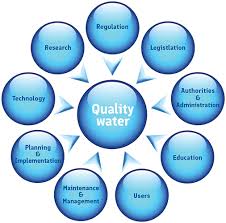
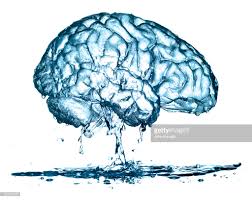 would be a great way to help operators avoid expensive shutdowns during operations. If you could imagine that if, during the process of producing food at a food processing plant or a semiconductor manufacturing plant, the odor control scrubber or fume control scrubber failed and caused a plant process shutdown, how expensive this could become. While making water at either an industrial or a municipal water treatment plant, the failure of an odor control scrubber could shut down the entire water treatment process, leaving the community without water. To help avoid costly shutdowns or “breakthroughs” on air emission requirements, companies like DeLoach Industries are developing “smart” “industrial water” and “odor control scrubber” equipment by integrating artificial intelligence” (AI) into the systems that they manufacture. By utilizing AI it will soon be possible for an odor control scrubber to “order” its chemicals when needed, or notify a service repair provider when the operating conditions change, and contact the operator as needed with information. This will also save the operator valuable time and avoid costly damage from system failures. Implementing AI and allowing the equipment to monitor itself beyond normal controls and to work autonomously within the treatment plant will provide higher uptime and reliability, prevent property damage, and help safeguard human life and the environment. To learn more about implementing AI into water, wastewater, and odor control scrubbers.
would be a great way to help operators avoid expensive shutdowns during operations. If you could imagine that if, during the process of producing food at a food processing plant or a semiconductor manufacturing plant, the odor control scrubber or fume control scrubber failed and caused a plant process shutdown, how expensive this could become. While making water at either an industrial or a municipal water treatment plant, the failure of an odor control scrubber could shut down the entire water treatment process, leaving the community without water. To help avoid costly shutdowns or “breakthroughs” on air emission requirements, companies like DeLoach Industries are developing “smart” “industrial water” and “odor control scrubber” equipment by integrating artificial intelligence” (AI) into the systems that they manufacture. By utilizing AI it will soon be possible for an odor control scrubber to “order” its chemicals when needed, or notify a service repair provider when the operating conditions change, and contact the operator as needed with information. This will also save the operator valuable time and avoid costly damage from system failures. Implementing AI and allowing the equipment to monitor itself beyond normal controls and to work autonomously within the treatment plant will provide higher uptime and reliability, prevent property damage, and help safeguard human life and the environment. To learn more about implementing AI into water, wastewater, and odor control scrubbers.
With today's demanding industry needs concerning odor emissions and off-gas treatment, our experienced design and manufacturing teams deliver success with the most stringent requirements. For industrial applications, DeLoach Industries has more than 50 years of skilled knowledge in supplying our petrochemical customers with engineered packaged systems to meet their needs in harsh environments. We design, manufacture, and ship our systems around the globe. DeLoach Industries offers complete design support, installation, startup training, and long-term operation and maintenance for all our odor control systems.
We specialize in these products to help your business combat odors and reduce air emissions:
- Odor Control scrubbers
- Biological scrubbers
- Chemical scrubbers
- Particulate filtration
- Prepackaged filtration skids
- Custom tank covers
- Fume control
- Dust control
- Portable pilot equipment
- Containerized treatment systems
Hydrogen Sulfide Wet and Dry Scrubbers
DeLoach Industries offers a complete line of pre-packaged odor control scrubbers for municipal, food, and industrial markets. Our professional design team can incorporate complete package systems into containers or structures to allow local or overseas shipping anywhere in the world. The systems available range from simple air filtration using HEPA filtration to more complex chemical and biological scrubbers. Air emission and scrubber treatment systems are available in counter-current flow or horizontal flow configuration, and single systems can achieve flow capacities of up to 70,000 SCFM.
We offer our customers the ability to analyze their off-gas processes with highly trained in-house specialists and engineers. They are skilled in developing and manufacturing air emissions and odor control solutions. DeLoach Industries offers chemical, chlorine, ammonia, caustic, and biological single-stage or dual-stage scrubbers. DeLoach also manufactures carbon absorbers and potassium permanganate-type scrubber systems. DeLoach Industries is an innovator in developing new technologies, and we have a complete line of proprietary close-loop odor control scrubbers and low-profile scrubber systems.
Biological Scrubbers
Using controlled biological activity, we employ biological scrubbers to efficiently remove H2S, VOCs, and other odors from air streams. They are designed for high treatment efficiency and maximum corrosion resistance. Biological scrubbing action minimizes chemical consumption and offers low ongoing operational costs. All biological scrubbers are designed and sized specifically to our customer's needs and fully packaged with complete automation components. Systems are available skid mounted or for slab installation. DeLoach Industries offers complete installation, startup, and training support.
DeLoach Industries offers a complete line of pre-packaged odor control scrubbers for municipal and industrial markets. Our professional design team can incorporate complete package systems into containers or structures to allow for overseas shipping worldwide. The systems are available in counter-current or horizontal flow configurations and can achieve flow capacities of up to 150,000 SCFM flow capacities.




 A
A
 would be a great way to help operators avoid expensive shutdowns during operations. If you could imagine that if, during the process of producing food at a food processing plant or a semiconductor manufacturing plant, the odor control scrubber or fume control scrubber failed and caused a plant process shutdown, how expensive this could become. While making water at either an industrial or a municipal water treatment plant, the failure of an odor control scrubber could shut down the entire water treatment process, leaving the community without water. To help avoid costly shutdowns or “breakthroughs” on air emission requirements, companies like DeLoach Industries are developing “smart” “industrial water” and “odor control scrubber” equipment by integrating
would be a great way to help operators avoid expensive shutdowns during operations. If you could imagine that if, during the process of producing food at a food processing plant or a semiconductor manufacturing plant, the odor control scrubber or fume control scrubber failed and caused a plant process shutdown, how expensive this could become. While making water at either an industrial or a municipal water treatment plant, the failure of an odor control scrubber could shut down the entire water treatment process, leaving the community without water. To help avoid costly shutdowns or “breakthroughs” on air emission requirements, companies like DeLoach Industries are developing “smart” “industrial water” and “odor control scrubber” equipment by integrating 




